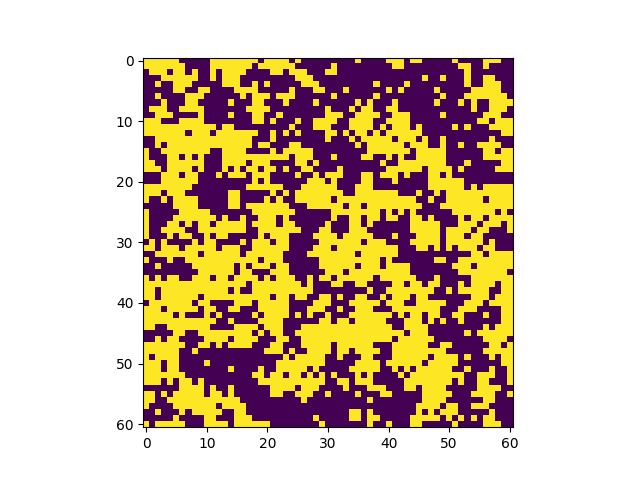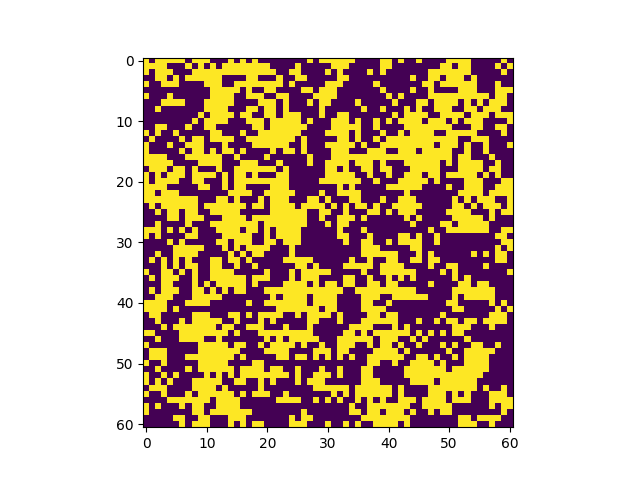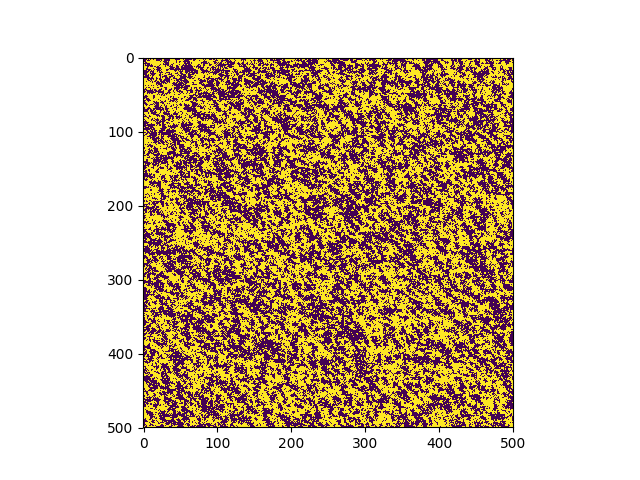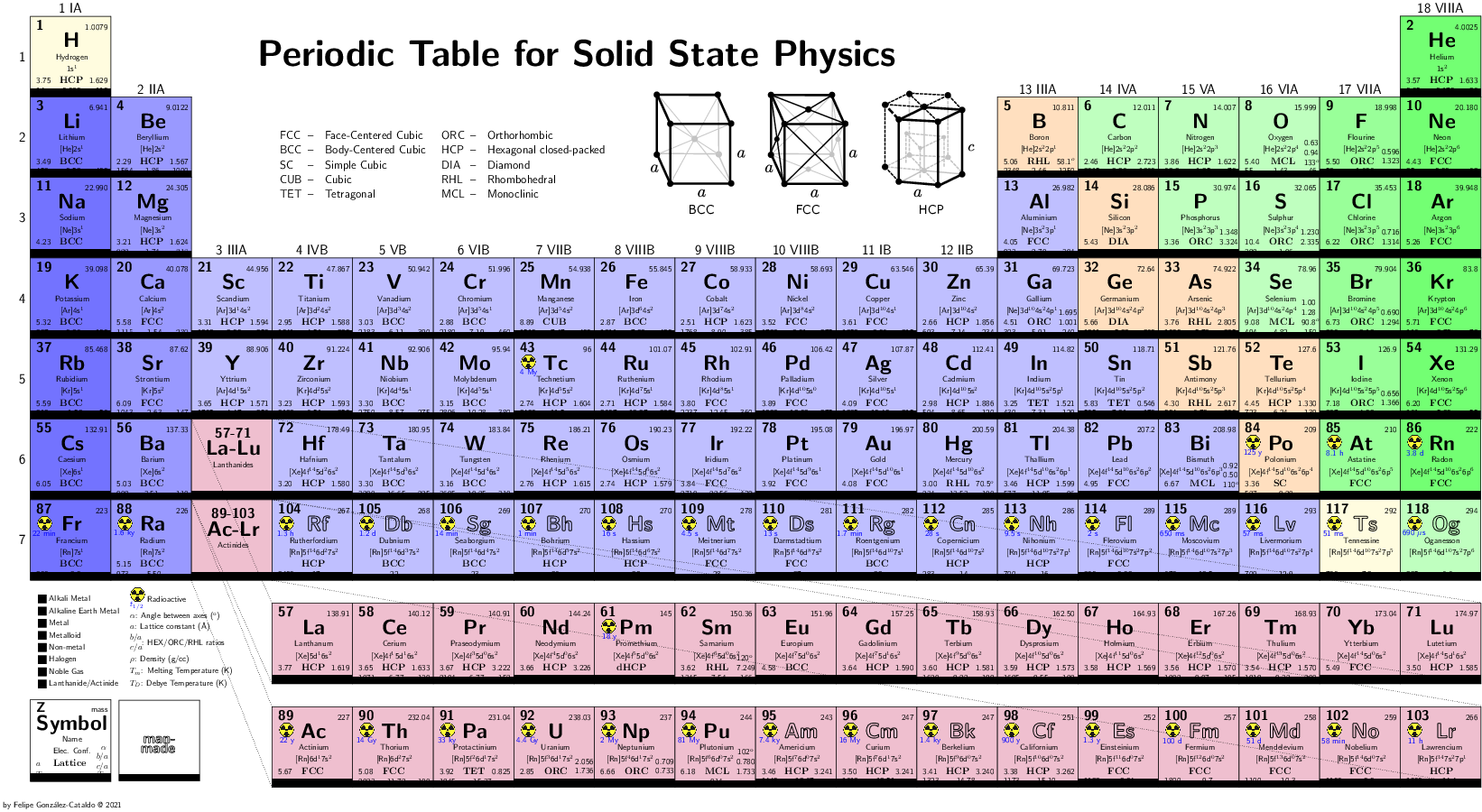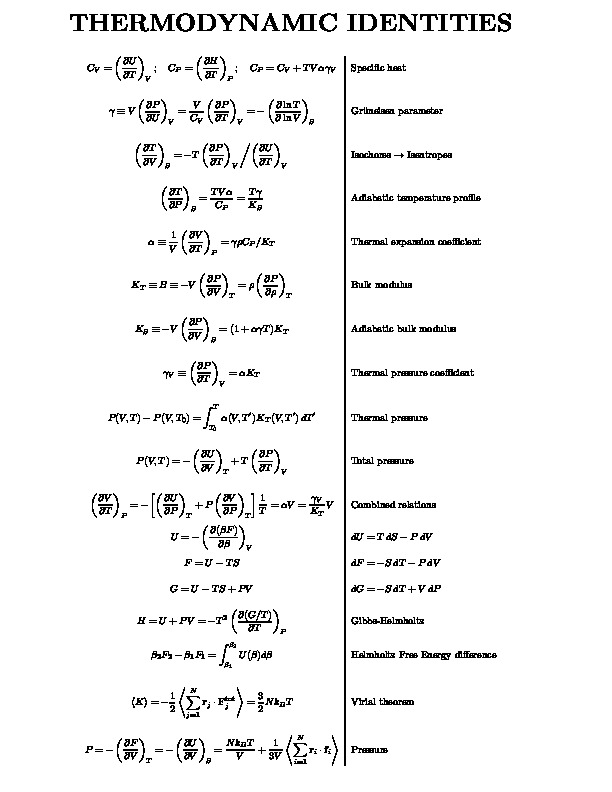Modelo De Ising
El modelo de Ising es un modelo matemático simple que permite estudiar un sistema de spines (o dipolos magneticos) interactuantes. El modelo en 2 dimensiones da cuenta de un cambio de fase a baja temperatura, en la cual el sistema se magnetiza. El Hamiltoniano que describe el sistema es
La interacción spin-spin se clasifica de la siguiente manera:
: ferromagnética
: antiferromagnética
: no interactuante
De acuerdo a la solución analítica, encontrada por Lars Onsager, la transición ocurre a una temperatura crítica
para el caso isotrópico (). La magnetización promedio está dada, en la solución de Onsager, por
EJEMPLOS
| Sin campo magnético externo |
|---|
La versión más simple del modelo de Ising considera interacción únicamente a primeros vecinos, sin la presencia den un campo magnético externo. El Hamiltoniano en este caso es
donde toma el mismo valor para todos los pares de spines.
El sistema se inicializa en una configuracion aleatoria de +1 y (-1) y evoluciona de acuerdo al algoritmo de Metropolis-Hasting. En tan sólo unos pocos pasos, el sistema se magnetiza. | |
La temperatura es mayor a la temperatura crítica. No hay transición de fase, el sistema no se magnetiza. | |
Transición de fase en un sistema más grande (500x500). |
Código (python)
#***********************************************************************#
#* THE ISING MODEL *#
#* *#
#* This program uses the Metropolis Monte Carlo algorithm *#
#* to simulate the Ising model, with Hamiltonian *#
#* ---- *#
#* H = \ -J_ij * Si*Sj *#
#* / *#
#* ----ij *#
#* *#
#* Adapted from B. Militzer course, EPS109, UC Berkeley, 2018. *#
#***********************************************************************#
# AUTHOR: FELIPE GONZALEZ CATALDO, September 2018.
from pylab import *
fig = figure(1)
ax = subplot(111)
# Jij = J for all i,j: Coupling constant (Jij>0: ferromagnetic, Jij<0: antiferromagnetic, Jij=0: non magnetic )
J= 1 # In eV, ferromagnetic
kT = 1.2*J # In eV
# ONSAGER SOLUTION FOR 2D LATTICE: kT = 2*J/(ln(1+sqrt(2))) = 2.2691853
n=61
mat = random(size=(n,n)) # Matrix of randoms in the interval [ 0.0 1.0 ]
mat = 2*floor(2*mat)-1 # Martrix of random 1's and -1's
img = imshow(mat)
show(block=False)
nBlocks = 100
for iBlock in xrange(nBlocks):
for ix in xrange(n):
ixp = (ix+1) % n # Neighbor to the right
ixm = (ix-1) % n # Neighbor to the left
for iy in xrange(n):
iyp = (iy+1) % n # Neighbor above
iym = (iy-1) % n # Neighbor below
s = mat[ixm,iy] + mat[ixp,iy] + mat[ix,iyp] + mat[ix,iym] # Sum of neighbors spins
mOld = mat[ix,iy] # Old value of the spin
EOld = -J*mOld*s # Si * (S_above + S_below + S_left + S_right)
mNew = -mOld
ENew = -J*mNew*s # sum_ij Si'*Sj, where Si' = -Si
Ediff = ENew - EOld # No need to sum over all the lattice, just this (ix,iy) site energy.
prob = exp(-Ediff/kT)
if ENew < EOld:
mat[ix,iy] = mNew
else:
mat[ix,iy] = mNew if random() < exp(-Ediff/kT) else mOld
#print iBlock
img.set_data(mat)
plt.pause(1e-30)
draw()
#savefig('is'+str(iBlock)+'.png')

